Slate.com recently published an interesting article by an Indiana University graduate who in 1966 created Project Flame, an early “computer” dating service. Students would fill out a punch-card questionnaire, but were not actually matched using a computer. Instead, he and his friends randomly shuffled the cards together to provide the illusion of computerized expertise.
Although Project Flame might have been a fraud, 1966 was a formative year for computer dating. The article referenced above from Look magazine describes Operation Match, a computerized dating system developed by two Harvard undergraduates, Jeff Tarr and Vaughn Morrill.1Gene Shalit, “New dating craze sweeps campus … boy …girl … computer”, Look Magazine, February 22, 1966 Within a few months, Operation Match received 8,000 applicants from nearby universities and colleges, 52% of whom were women. (Like early Facebook, the target audience was the Ivy League and associated schools: Harvard, Yale, Vassar, Amherst, William, Mount Holyoke). Within nine months, Tarr and Morrill had attracted 90,000 applicants and grossed $270,000, all using rented computer time. An alternate system called Contact was started at MIT by David DeWan. His system drew 11,000 applicants.
Interestingly, the Look article ends by talking about the need for mutual deception within the computer dating environment:
Boys have discovered that there is more to getting the girl of their dreams than ordering a blonde, intelligent, wealthy, sexually experienced wench. They must also try to guess what kind of boy such a girl would request, and describe themselves to conform to her data. The future suggests itself: the boy answers artfully. A girl does took. The computer whirs. They receive each other’s name. Breathlessly, they make a date. They meet. They stop short. There they are: Plain Jane and So-So-Sol. Two liars. But they are, after all, exactly alike, and they have been matched. It is the computer’s moment of triumph.
After a flurry of media coverage of these and similar systems, the computer dating fad of the mid-1960s seems to have quieted down quickly.2Russell Baker, “Automation Comes to Love: Computerized Mating, New York Times, Feb 10, 1966
By the early 1970s, the focus had turned to the dark side of computer dating, including fraud, misrepresentation, and violations of privacy.3 Steven Roberts, “Often, Computers Spoil Cupid’s Aim,” New York Times, Dec 25, 1970
Perhaps the most bizarre twist from this period was a Times Square bookseller who used its customer data to start its own computerized dating service — without their customer’s knowledge. They set up a dial-a-date service advertising “Girls Galore.” Women who found themselves besieged by calls from strangers experienced “anxiety and fear.” The first example of computer-related stalking, perhaps?4 “Stores Sell Names Of Women Using Dating Computers,” New York Times, Jul 30, 1968
UPDATE: an obvious question to ask about computer dating in this period is “why 1966”?
The short answer to this question is that this is the late 1960s was the heyday of the computer utility. These were services that allowed users to rent time on a shared mainframe computer, generally via a remote terminal. The practical upshot was that entrepreneurs who wanted to provide computer-based services, but who did not have the resources (or desire) to own their own computer, could rent time via a computer utility such as Tymshare, University Computing, GE Information Systems, or the Service Bureau Corporation.
The era of the computer utility was short-lived, as the difficulties associated with writing time-sharing software (see my recent post on Why Software is Hard) and competition from low-cost minicomputers demolished the revenue models of the computer utility. By these computer utilities, however transitory, represented an important moment in the democratization of computing. As one professor in the MIT School of Management described it in 1964, the vision of “an on-line interactive computer service, provided commercially by an information utility … as commonplace … as the telephone service is today” was a compelling one, and would be recreated, via the Internet, in later decades.5Martin Greenberger, quoted in Campbell-Kelly, Aspray, Ensmenger, and Yost, Computer: A History of the Information Machine (Westview Press, 2013)
In terms of the history of computer dating, the existence of the computer utilities dramatically reduced the barriers of entry into computer-based services. The sudden rise of multiple dating services in 1966 are anything but a coincidence.
ANOTHER UPDATE:
Youtube video on a London-based computer dating service (also called Operation Match)
Hat tip: Alex Bochannek
- 1Gene Shalit, “New dating craze sweeps campus … boy …girl … computer”, Look Magazine, February 22, 1966
- 2Russell Baker, “Automation Comes to Love: Computerized Mating, New York Times, Feb 10, 1966
- 3Steven Roberts, “Often, Computers Spoil Cupid’s Aim,” New York Times, Dec 25, 1970
- 4“Stores Sell Names Of Women Using Dating Computers,” New York Times, Jul 30, 1968
- 5Martin Greenberger, quoted in Campbell-Kelly, Aspray, Ensmenger, and Yost, Computer: A History of the Information Machine (Westview Press, 2013)
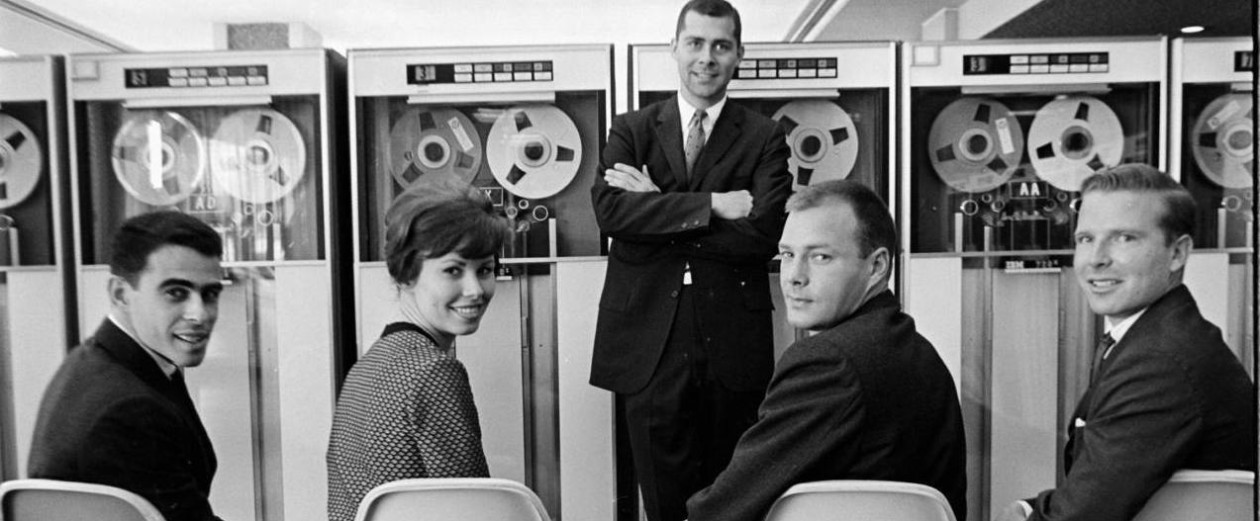
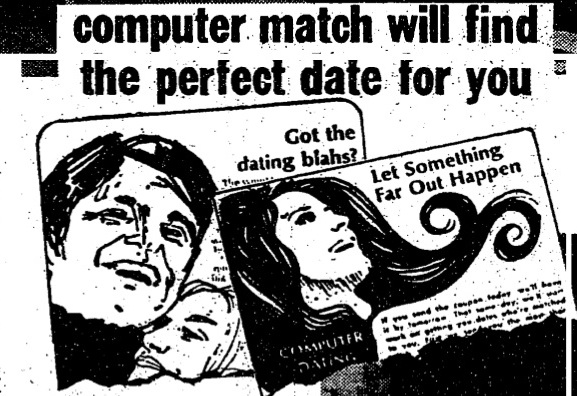
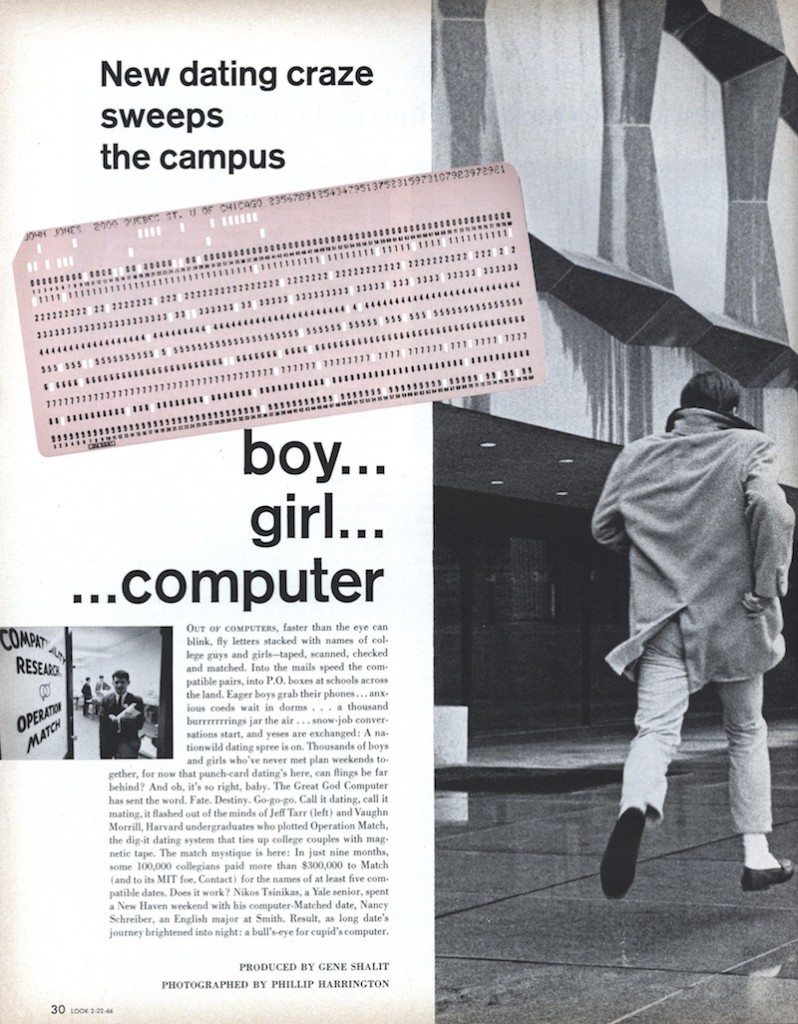
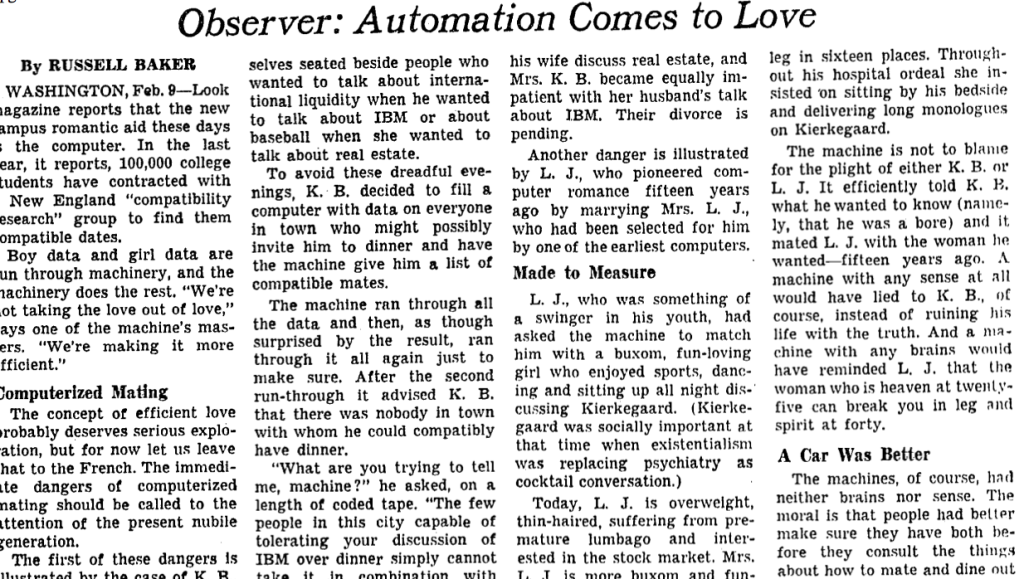
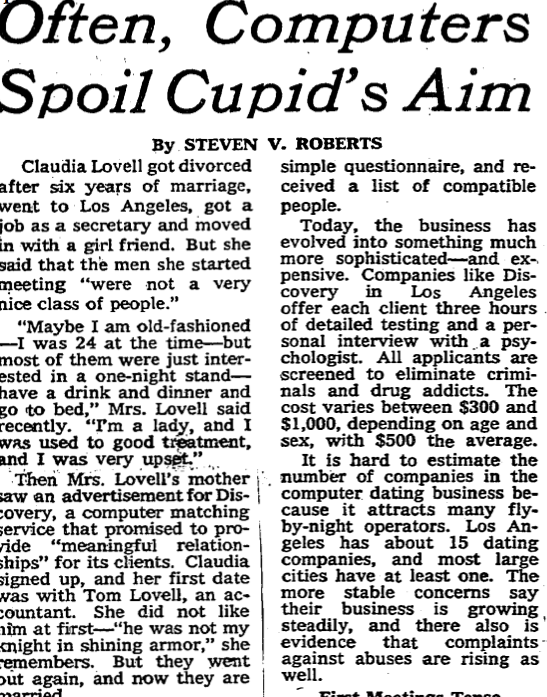
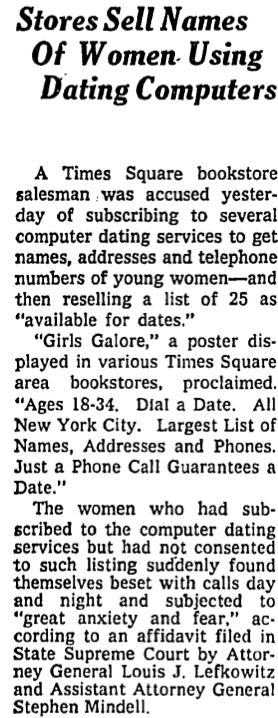
 Follow
Follow
Really enjoyed this post–read it as I prepared to give a talk on the history of computer matchmaking at SHOT (Albuquerque). One thing that seems really interesting to me is how these matchmaking services generally either seemed to be started by sleazy bachelors or come out of the marriage bureau industry/tradition. Seems like the different camps might have engineered very different social expectations into their respective systems. Did that even matter to the end result, I wonder?
Would you mind adding the references for the newspaper articles if you have time? I would especially love to look up the (New York?) Observer one to read the rest…
Great idea! I should have included these references in the first place. I have updated the post with footnotes.
I enjoyed this article. I am trying to find any information referencing a computer matchmaking service in the Denver/Boulder area in 1966- my parents met through it and are about to celebrate their 50th anniversary! They cannot, however, remember anything about the service at all. I thought that if I could find at least SOMEthing of note, it could be a fun anniversary gift. If anyone knows how to help, let me know!
How funny, but my parents met through a computer dating service in Denver in 1964 and we are trying to find out what the name was. They can’t remember. Today we are going to StoryCorps to record their story. Jonathan if you ever find out the name, please post, I would love to share.
Hi Jonathan, I’m research this exact thing in relation to the interview the commentor Karyn’s parents recently did. I would love to talk to you about what you do or don’t know of it. Please email me at production[at]storycorps[dot]org
My husband started a computer dating in Europe called Dateline and based in London.
This was in 1967.
He was called John Patterson.